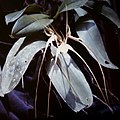| Spider orchid | |
|---|---|
 | |
| Brassia arcuigera | |
| Scientific classification | |
| Kingdom: | Plantae |
| Clade: | Tracheophytes |
| Clade: | Angiosperms |
| Clade: | Monocots |
| Order: | Asparagales |
| Family: | Orchidaceae |
| Subfamily: | Epidendroideae |
| Tribe: | Cymbidieae |
| Subtribe: | Oncidiinae |
| Genus: | Brassia R.Br. [1] |
| Type species | |
| Brassia maculata | |
| Synonyms [1] | |
| |
Brassia is a genus of orchids classified in the subtribe Oncidiinae. It is native to Mexico, Central America, the West Indies, and northern South America, with one species (B. caudata) extending into Florida. [1] [2]
Contents
The genus was named after William Brass, a British botanist and illustrator, who collected plants in Africa under the supervision of Sir Joseph Banks. Its abbreviation in the horticultural trade is Brs. [3]




